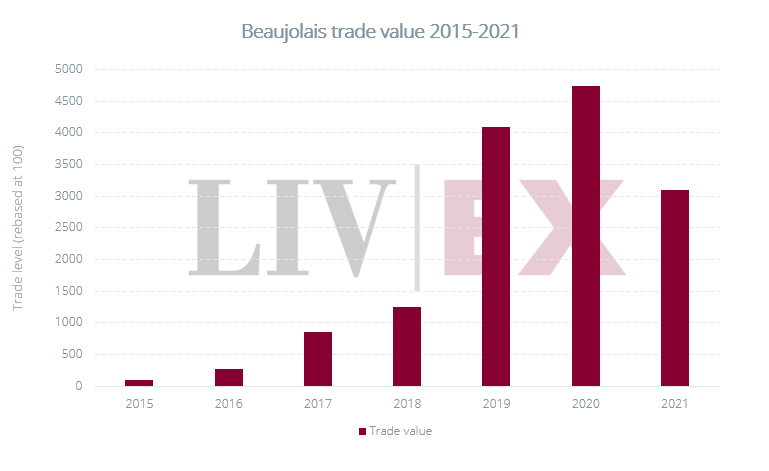- Beaujolais trade has been growing steadily in value since 2015.
- Morgon has been the most-sold cru by value with Foillard, Lapierre and Métras being some of the most popular producers.
- Beaujolais trade in 2021 is currently lagging behind 2019 and 2020.
Beaujolais’ total value in the secondary market may be small, but with natural winemakers and demand for Morgon and Fleurie leading growing trade, the region has come a long way since the heyday of Beaujolais ‘nouveau’ in the 1980s-1990s.
Beaujolais trade has been growing steadily since 2015
Beaujolais activity on the secondary market truly began in 2015, with Thibault Liger-Belair’s Moulin-à-Vent Les Vieilles Vignes 2010 being the first wine to trade. And like Austrian trade which was covered yesterday, it has been growing ever since.
Like Austria, Beaujolais is a tiny player in the market. Trade may have grown but is not going to challenge Bordeaux, Burgundy, Champagne or the Rhône any time soon.
Representing just 0.1% of French trade by value this year, Beaujolais activity is very slightly behind that of Alsace (0.1%) and the Loire (0.2%).
Leading producers and appellations
Beaujolais trade is dominated by what are undoubtedly the three crus held in the highest regard: Morgon, Fleurie and Moulin-à-Vent respectively. Morgon alone has accounted for 87.8% of total Beaujolais trade by value since 2015.
So far this year, the leading producers traded by value are Jean Foillard, M&C Lapierre and Yvon Métras. The Morgon Côte du Puy from Foillard has led trade, with the 2018 vintage up 43.6% year-to-date with a current Market Price of £326 (12×75).
These three producers are among a small group credited not only with leading the revival of Beaujolais winemaking as well as sparking the trend for ‘natural’ wine in France which has subsequently spread far and wide.
Beaujolais trade since 2015
As can be seen in the chart above, Beaujolais trade has grown exponentially since 2015. Last year proved its biggest year to date. Trade value grew over 4,600% in the five years from 2015-2020 (from an extremely small base).
After two very strong years in 2019 and 2020, however, trade in 2021 has not been as strong. Beaujolais activity this year is 34% lower by value than in 2020, with trade volumes 37% lower.
Nonetheless, trade remains substantially higher than in the first four years (2015-2018) of sustained Beaujolais trade.
For all LIVE Beaujolais opportunities, click here.
Liv-ex analysis is drawn from the world’s most comprehensive database of fine wine prices. The data reflects the real time activity of Liv-ex’s 530+ merchant members from across the globe. Together they represent the largest pool of liquidity in the world – currently £80m of bids and offers across 16,000 wines. Independent data, direct from the market.







